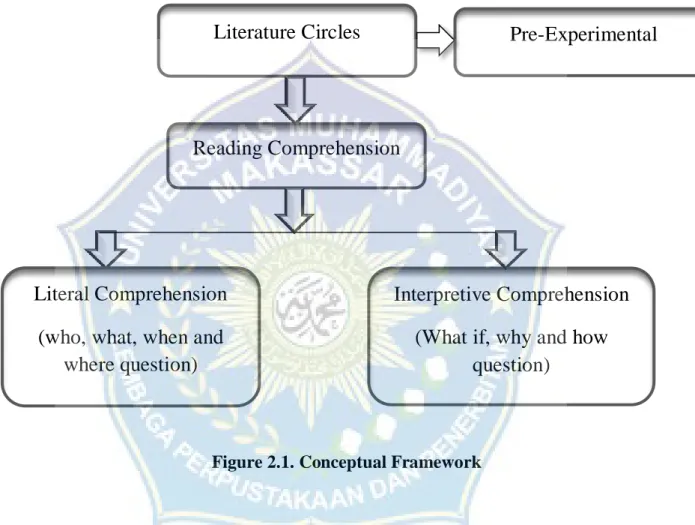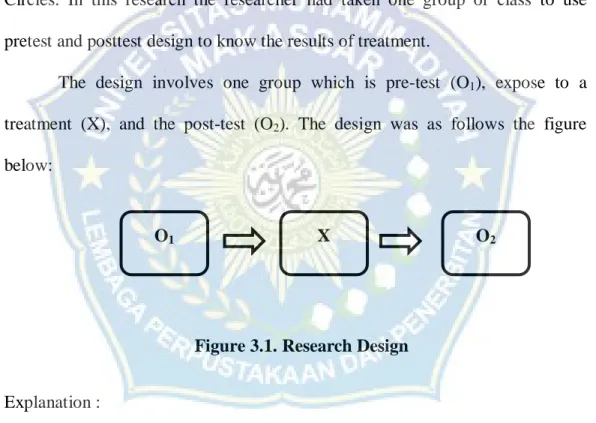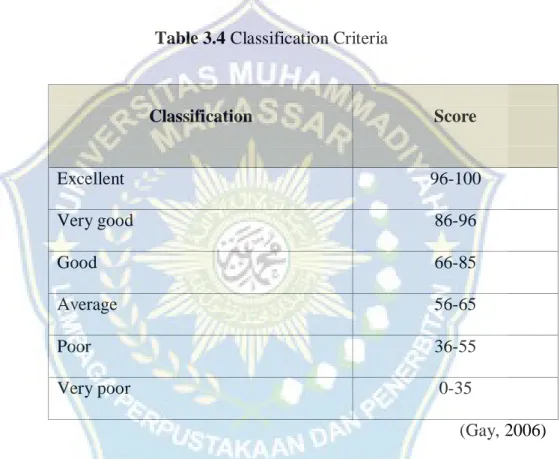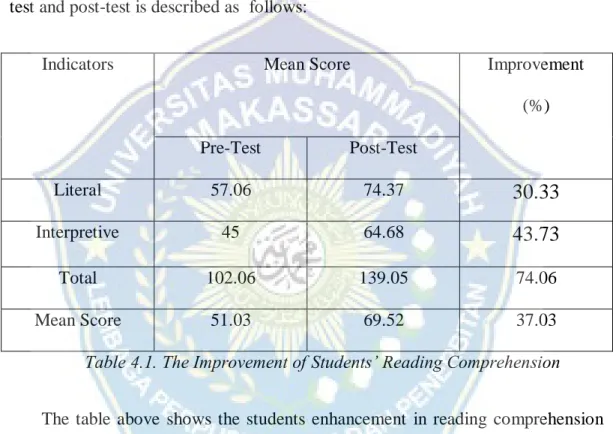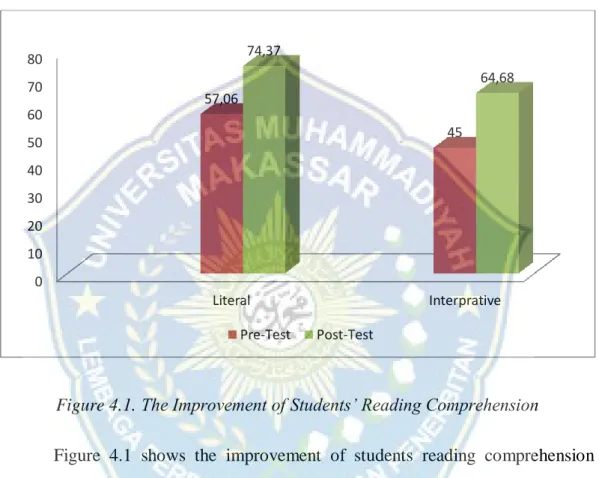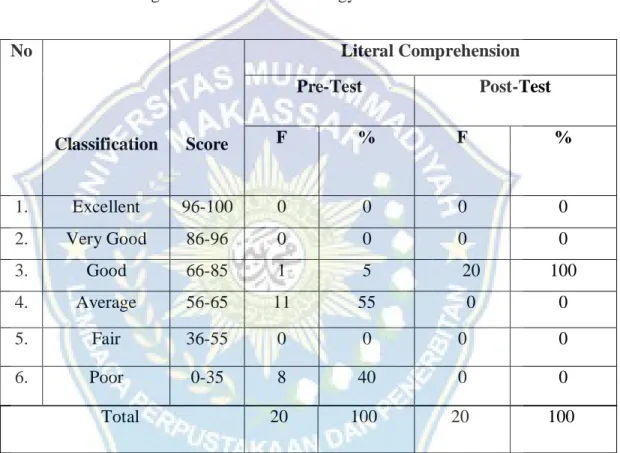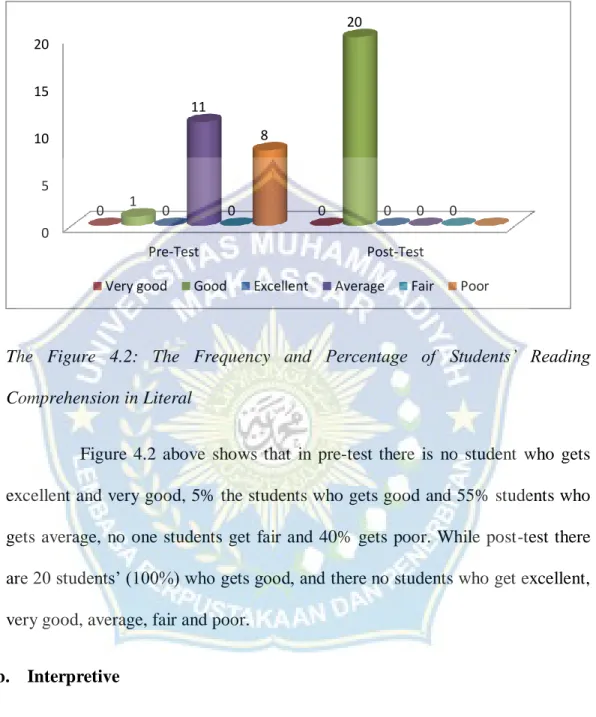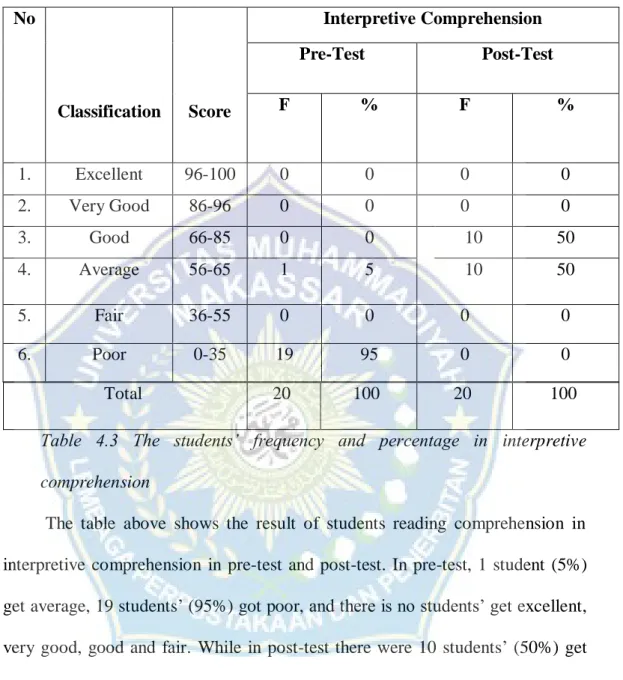Using Literature Circles Strategy to Improve Students' Reading Comprehension (Pre-Experimental Research in Eleventh Grade SMA Negeri 10 Jeneponto). The purpose of this research was to determine the improvement of students' reading skills using the strategy of literature circles to improve students' reading comprehension in terms of literal and interpretive comprehension. In other words, the use of literature circles strategy was effective to improve students' reading comprehension in terms of literal comprehension (asking what, who, when, and where) and interpretive comprehension (asking what if, why how) in eleventh grade SMA. Negeri 10 Jeneponto.
The use of literature circles strategy to improve students' reading comprehension” is presented as the final requirement for achieving undergraduate degree at the English Education Department, Faculty of Teacher Education and Training of Universitas Muhammadiyah Makassar. Ummi Khaerati Syam, S.Pd., M.Pd., the Head English Education Department FKIP Muhammadiyah University of Makassar. Therefore, the researcher chooses "The Use of Literature Circles Strategy to Improve the Students' Reading Comprehension" as the title of this research.
To know whether participation in literary circles leads to an improvement in students' reading comprehension in terms of literal comprehension. To know whether participation in literary circles leads to an improvement in students' reading comprehension in terms of interpretive understanding.
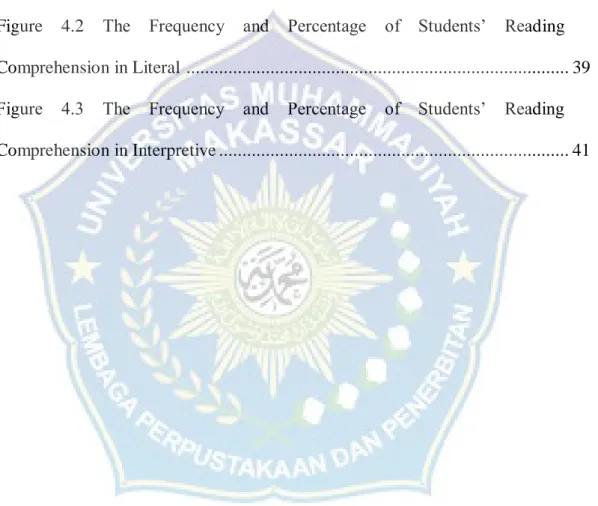
Problem Statement of The Research
Objectives of the Research
Significance of the Research
Scope of the Research
Provious Related Findings
The result of this study shows that literature circles contribute to a significant effect in improving students' reading comprehension. The similarity with this research is the use of literature circles in the teaching and learning process of English to improve students' reading comprehension and the difference was that the previous research was using quasi-experimental design, but in this research it is using used pre-experimental design. Briggs (2010) entitled "Using Literature Circles to Increase Reading Comprehension in Third Graders".
The result of this study showed that through the use of literature circles, students developed better comprehension skills and at the same time improved the social skills that will lead to enriched learning.
The Concept of Literature Circles
- Definition of Literature Circles
- Benefits of Literature Circles
- Teaching Process of Literature Circles
- Teacher‟s Role in Literature Circles
- Sharing and Discussion
According to Daniels (2002), literature clubs provide opportunities for students to engage with their peers about selected texts. Furthermore, Daniel (2006) stated that literature circles are small discussion groups led by peers who have decided to read the same story, poem, article or book. Next, Lloyd (2004) argues that implementing the strategy of literature circles is a way to engage students in reading and gain independence for their own reading.
This means that the literature circles are a strategy so that students are more independent in reading texts that they choose themselves. And also according to Greef (2002), Literature Circles are used in the classroom in small groups based on students' literature interests. According to Rogers and Leochko (2002), Literature Circles are a forum that provides opportunities for students to interact with reading material on various levels.
Literature Circles attracts students' reading interest beyond just reading traditional literary works, and summarizes activities and arouses their reading interest in literature as students find an atmosphere of collaborative and cooperative social learning in the literary environment. According to their research, the role of the Facilitator involves the teacher in encouraging interactions and conversations between students.
The Concept of Reading Comprehension
- Definition of Reading Comprehension
- The Element of Reading Comprehension
- Reading Comprehension Level
- Factors of Reading Comprehension
- Kind of Reading
- Reading Process
- The Perpose of Reading
The role of the connector is to try to find the connection between the text and the real world in which we live. The contact person should find some of the group's experiences that relate to the short story. This means that using words that extract and construct to emphasize both the importance and inadequacy of the text as a determinant of reading comprehension, in other words reading comprehension is how to understand a written text.
Furthermore, Guthrie (2004) argues that reading comprehension consists of the process of building conceptual knowledge of a text through cognitive interaction and motivational engagement with the text. These components are the reader, their background knowledge, their reading strategy, the text, their interest in the subject and their knowledge of the type of text. Processing text includes encoding the text, high-level linguistic and semantic processing, and self-checking for comprehension.
Knowledge of emotional reactions to literary techniques - Knowledge of the reaction to form, style and structure. The students' understanding of the meaning of the individual words is closely related to their ability to understand coherent texts.
Conceptual Framework
Research Hypothesis
- Research Variables and Indicators
- Population and Sample
- Instrument of the Research
- Technique of Data analysis
After giving the pretest, the researcher gave a treatment using the power of Literature Circles Strategy to increase students' understanding of English. The teacher will explain that in the LKS the teacher gives words that will be discussed by the students. The teacher asks the students to choose a leader in their group and determine the position of each member.
The teacher asks the students to write down the answers to the questions in the text after the students read the text and after discussing them in the text. The teacher asks the students to do the assignment given by the teacher. The test was similar to the pre-test, but literature circles were used in the post-test.
In this research, the independent variable is the literature club strategy in improving students' reading comprehension. The dependent variables in this research are improving reading comprehension in terms of literal and interpretive comprehension. Students are able to respond to opinions and provide general support and facts from the text.
The subjects of this research are the students of the second class of the Senior High School in SMAN 10 Jeneponto in the academic year 2020/2021. The population of this study consists of the 11th grade students of SMAN 10 Jeneponto, which consists of eight classes, 4 science classes and 4 social classes. In the pre- and post-test, the researcher gave a reading text (narrative text) and asked the students to read it carefully. The students then answered the questions based on the text to measure the students' reading comprehension.
After collecting data about students, we classify the results of students into the following criteria. In order to find a significant difference between the pre-test and post-test score, the researcher calculates the test value using the following. The sum of the squares of the differences between. pretest and posttest.
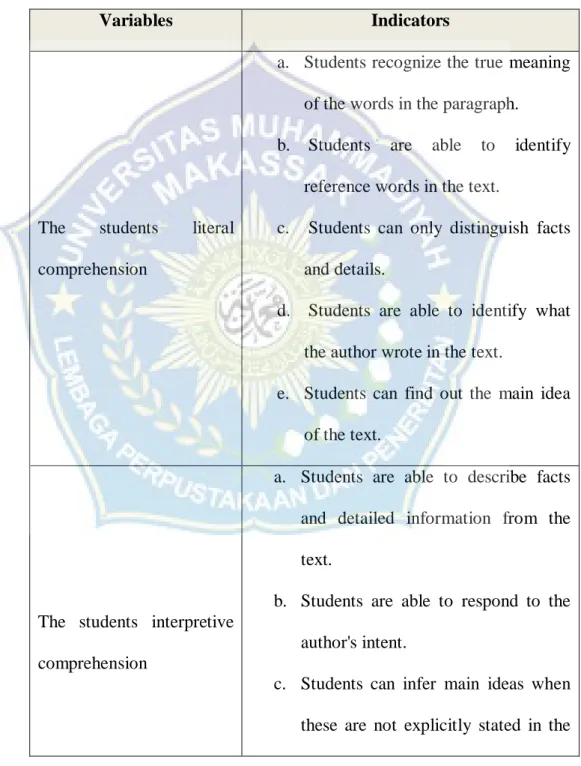
Discussion
The description of data collected from the students' reading comprehension especially in literal comprehension and interpretive comprehension as explanation in the previous. As Harmer (2007) states that reading for general understanding means not stopping for every word, not analyzing everything the researcher includes in the text. High school students are learning various skills in English, and one of them is reading.
In a process research, from pre-test to post-test, the researchers analyzed the students' ability to answer questions based on the given text, is still lacking and needs to be improved. Most students are unable to highlight the main idea and some important statements in the text, which are the answer to the question asked. The above findings prove that in the preliminary test there is no student who scored excellent, very good and 1 student (5%) got good, 11 students (55%) average, and 8 students (40%) bad. result.
All results are only classified as moderate to good level because the students' literal understanding of the text is worse, the students do not fully answer all 5 questions related to literal understanding. The results, as stated above, are that the researchers found a significant increase in the scores of the students from the 20 samples in the post-test. The percentage in the post-test that students achieved very good results was higher than the percentage in the pre-test.
The students were able to comprehensively and comprehensively answer the questions related to the literal understanding of the text. Using the strategy of literature circles is very effective in teaching reading to high school students. In fact, based on previous researchers, most students scored well on the post-test.
Regarding the results in each meeting of the treatment, the researcher concluded that the students enjoyed the class and they felt that it was easy to read the text because they had been guided earlier. Interpretation comprehension is one of the important factors to prove that students can understand the whole text. In the given treatment, the researchers formed groups and treated them according to the Literature Circles strategy.
Suggestion
One day, in the middle of the roar of the waves of Air Manis beach, Malin Kundang made his intentions known to his mother. However, it turned out that Malin Kundang had changed and was arrogant, he did not want to recognize the woman who came in in torn clothes as his mother. 34 "I don't have a mother as despicable and poor as you, you old bastard who doesn't know yourself!" Malin Kundang said to a woman who is indeed his biological mother.
Malin Kundang then left, leaving his mother still on her knees crying sadly. Malin Kundang called his mother's name, but God's majesty came, Malin Kundang, a disobedient child, drowned with his boat and was stranded on the edge of Air Manis beach. Why does Malin Kundang refuse to accept his mother when he returns to the village.
Malin Kundang: At first had a good character, dear to his parents, but after getting rich, Malin Kundang became arrogant. Even though their lives are simple, at least Malin Kundang will not be arrogant and disobedient to his mother. After becoming rich and having a wife, Malin Kundang became arrogant and did not acknowledge his mother.
Lesson Plan
Pre-test Worksheet
Post-test Worksheet
Findings in chapter IV
Documentation
